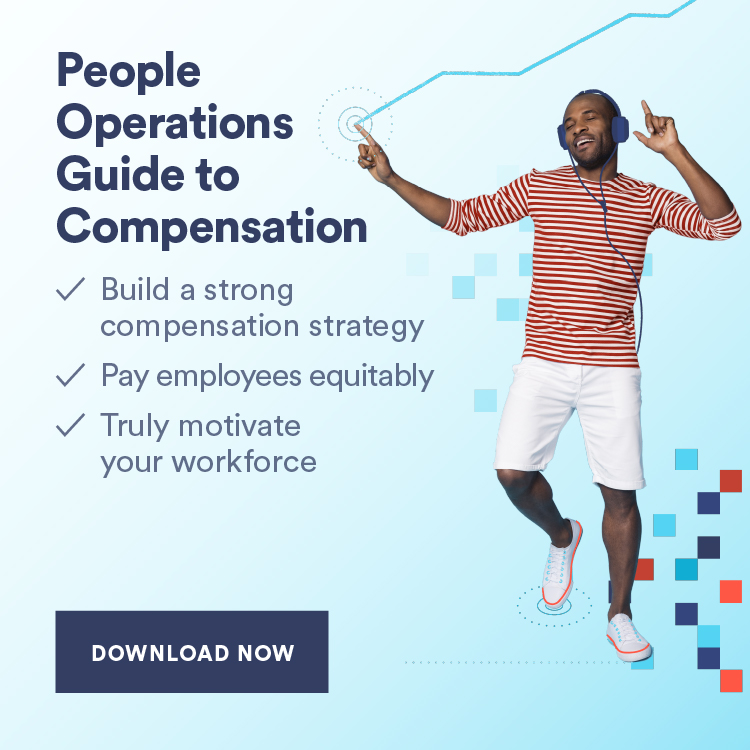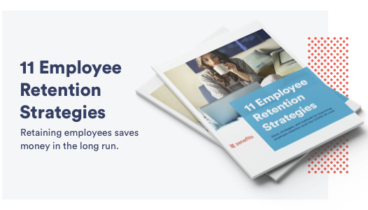Building a Strong Compensation Plan: Our Definitive Guide
A strong compensation plan is essential for businesses seeking to hire and retain qualified employees. Follow our guide to how and why to build one.
Here's what you need to know:
-
A compensation plan helps you attract and retain top talent
-
Compensation isn't just about salary, it includes incentives and benefits too
-
There are several compensation-related laws you will need to take into account
Note: This story was last updated January 31, 2023
The business of employment is ever-changing. The labor market ebbs and flows, workplace laws evolve, and business needs fluctuate — sometimes from one extreme to another. Still, some things have remained constant. Among them is the value of employee compensation.
Compensation plays a significant role throughout the employment life cycle. It’s a draw for attracting and securing qualified candidates during the hiring process. And it’s key for helping employers to keep high performers on board by remaining competitive within the talent marketplace. To achieve these outcomes for your company, you’ll need an intelligently designed, well-built compensation plan. In this guide, we’ll show you how to develop one.
Here we’ll cover the following:
- What is a compensation plan?
- The 2 types of compensation.
- Eight steps to creating your compensation plan.
- Specialized compensation plans and employee compensation packages.
- What to do if you don’t have much money in the budget.
- How to review and audit your compensation plan.
What is a compensation plan?
A compensation plan is a formal written document describing the company’s position on total rewards provided to employees for services rendered. A good plan addresses the following:
- Who (i.e., which employees) is/are to be compensated.
- What types of compensation will be provided (e.g., salaries, benefits, bonuses, etc.).
- Why the compensation is offered (e.g., standard pay package, employee incentives).
- How much (i.e., the amount and/or value of each type of compensation).
- How often (i.e., the frequency of the specific compensation).
Once implemented, a strong and competitive compensation plan should:
- Support your business strategy and your operational and workforce needs.
- Keep you competitive within your industry.
- Attract and retain high-performing, qualified talent.
- Improve employee performance and job satisfaction.
- Help define your competitive market position in terms of base pay, incentives, and benefits.
- Help establish a total rewards plan based on your compensation budget, competition, and business conditions.
Types of compensation
Before you develop your compensation plan, be sure you understand the different types of compensation. Categorically, there are 2 overarching types: direct and indirect.
Direct compensation
Direct compensation refers to salaries and wages paid by employers to employees for work performed. It is monetary — such as base pay, variable pay, and differential pay.
Base pay
This is the employee’s hourly rate or an annual salary, without additional pay like overtime or incentives. It’s the foundational amount that you offer new hires. Generally, this amount increases or decreases over time based on the employee’s performance.
Base pay can be a solid indicator of the value your company places on an employee’s role and contributions. Moreover, a few factors must align for base pay rates to be effective. The organization and employees must view them as sustainable, externally competitive, internally equitable, legal and defensible, and easy to understand.
Variable pay
Variable compensation is pay that isn’t automatically set for the same amount every time. Variable pay may hinge on various factors and is usually based on reaching desired outcomes. An individual’s, team’s, or company’s performance is typically the basis for variable compensation. This structure is often used as part of a sales compensation plan.
Increasingly, organizations are offering variable pay based on employee performance or results achieved. Variable payment can increase employee engagement, productivity, and earning potential. For the employer, it risks less of the payroll budget.
Variable pay is incentive-driven. It can take the form of short- and/or long-term incentives, including:
- Commission plans.
- Profit-sharing plans.
- Stock options and stock-based plans.
- Deferred compensation.
- Signing bonuses.
- Cash recognition awards.
Some jobs are a mix of base and variable pay. For example: salespeople who receive salary plus commissions.
Differential pay
Also called “premium pay,” differential pay is extra wages paid to employees for working undesirable shifts (i.e., nights or weekends). It can also apply to employees working under adverse conditions (such as unusually cold weather). Differential pay is typical in the manufacturing industry.
Indirect compensation
Indirect compensation refers to the benefits an employer offers employees, whether voluntarily or mandatorily. These often include:
- Health insurance, health savings accounts (HSAs), and flexible spending accounts (FSAs).
- Employer assistance program; wellness benefits.
- Retirement plans; matching contributions.
- Paid holidays, vacation time, and other paid time off.
- Educational and development programs; tuition assistance.
- Disability, life, and supplemental insurances.
- Fringe benefits and perks, such as discount programs and company-provided equipment, vehicle, or lunches.
Now that you know what constitutes “compensation,” let’s move on to creating your compensation plan.
8 steps to building your compensation plan
1. Define your underlying compensation philosophy
Your company’s compensation philosophy is its moral position on pay and benefits based on your company values. Its consistent framework helps guide your principles about how you dole out money. It also informs what compensation stands for at your company. Ultimately, it’s about paying people the appropriate rate for the work they’re doing and the experience they bring.
Your compensation philosophy will be unique to your company. Best practice dictates adopting a fair compensation policy indicating that one’s pay should match their merits, tenure, and skill sets. It remains unbiased in terms of age, gender, race, religion, or protected categories. It should stay competitive with other similar roles in similar geographic areas. Fair pay also ensures compliance with employment laws.
2. Know what you want to achieve
This helps you figure out what skills you need on staff and how to prioritize new hires accordingly. It also helps inform incentive strategies to drive intended outcomes among current employees.
For example, if you need to plug talent gaps, you may take the following steps:
- Write down your business goals.
- Rank the goals based on priority. What objectives must you achieve vs. those you’d like to achieve?
- Define what’s/who’s needed to achieve those goals. Who are the people, and what skills and experience levels are required to achieve the goals?
- Document your “people gaps.” Wherever you’re missing talent, record the gap — you must write out where your business is missing key hires. This demonstrates your ability to anticipate human capital needs. It also buffers the People Operations team from finger-pointing when key business goals are missed.
- Devise a compensation strategy for each gap. You can utilize compensation benchmarking tools to inform your talent costs. Also, you may want to offer higher pay rates for more urgent roles.
- Share your results with your leadership team. Let’s assume you’ve defined your talent gaps and estimated the costs to fill them. The final step is to make strategic recommendations on filling the roles. This could be an internal change in roles and responsibilities. It could also entail attracting, recruiting, and hiring new people.
3. Conduct a job analysis for all positions in your company
A job analysis gives you the knowledge to set appropriate pay ranges for each position. The analysis involves carefully observing the role to determine the following:
- Its duties and responsibilities.
- Its importance compared to other positions.
- The qualifications required to execute the role.
- The working conditions for performing the job.
4. Obtain pay rates for all positions, and develop pay ranges
You’ll need to understand the going rates for all roles, including salaried employees, hourly employees, and any open positions. You can reach out to your personal network or research info from the U.S. Bureau of Labor Statistics. Either way, you will likely need to dig further for more meaningful data.
A more reliable solution is to leverage compensation benchmarking tools available from platforms like Indeed, Glassdoor, Salary.com, LinkedIn Salary, and Zenefits. Salary benchmarking tools offer actual, real-time salary data for specific jobs in specific geographic regions. In addition, they can provide median wages and salary ranges based on quartiles and estimate salary changes. This info helps project whether demand for the role will increase or decrease.
5. Decide which benefits to offer
This decision of which benefits to provide as part of your compensation plan is driven by several variables, including:
- Full-time vs. part-time employment.
- Exempt vs. nonexempt employees.
- What benefits your competitors offer.
- Which benefits you’re legally required to provide or offer.
- The benefit needs of your workforce.
- What benefits you can afford to provide.
6. Do not overlook the power of incentives as part of your total compensation plan
Incentives are the perks (typically monetary, but not always) used to motivate existing employees. Examples include bonuses, company stocks, paid holidays, and gifts or vouchers. They should tie as closely to performance as possible.
Take note that not all incentives are created equal. Poor incentives fail to motivate staff and may put your company at risk for high employee turnover. Conversely, employers who leverage strong incentives can see an increase in revenue, profits, productivity, and employee retention.
A soundly constructed incentive compensation plan covers the following:
- Determining the target employees.
- The requirements for earning an incentive.
- The rewards employees can expect for achieving the goals or standards.
- All related timelines for earning and payment of the rewards.
Your incentive compensation plan should support efforts that move the business closer to its goals. Ensure that it’s clear and potentially achievable by all without favoring any particular subgroup. Finally, it should make sense fiscally and within your business’s infrastructure.
7. Stay in tune with your compensation budget
Your compensation budget gives you a sense of how many people and what level of experience you can afford to hire. It also helps inform current employees’ raises, promotions, and compensation adjustments.
Your budget helps define the following:
- The total number of people you can afford to put on your payroll.
- The extent of and types of incentive strategies you can use.
- Salary ranges for various positions.
- The mix of total compensation (salary, benefits, and perks) you can provide to each worker.
- The combination of worker types that are best to keep (contract, full-time, part-time, etc.).
8. Take applicable laws into account
Consider the federal, state, and local laws relevant to your business when drafting a fair compensation plan. Some of the most common compensation-related laws include the following:
- Title VII of the Civil Rights Act.
- Americans with Disabilities Act (ADA).
- Age Discrimination in Employment Act (ADEA).
- Fair Labor Standards Act (FLSA).
- Equal Pay Act (EPA).
- Affordable Care Act (ACA).
- Employee Retirement Income Security Act (ERISA).
- Family and Medical Leave Act (FMLA).
- State and local wage and benefits laws.
Specialized compensation plans
Depending on how your business is structured, you may need to create specialized compensation plans. Let’s look at the different considerations for executives and salespeople.
Considerations for executive compensation plans:
- The organization’s long-term and short-term goals.
- What your direct compensation will be, typically based on industry, organization size, and sales revenue.
- Annual incentives and bonuses, typically based on executive performance and a percentage of profits.
- Long-term incentives. These are typically offered to select leaders who directly influence organizational performance and success.
- Incentive stock options and restricted stock grants.
- Special benefits and additional compensation, such as supplemental health and wellness benefits, non-qualified retirement plan, and company-provided vehicle.
Considerations for sales compensation plans:
- Will you offer salary and commission, or only commission?
- Will the plan consist of salary and incentive, or only salary?
- Will incentive earnings be allocated as a dollar amount, or a percentage of base pay or sales generated?
- Does the plan meet both your organizational needs and your budget?
- Does the plan facilitate ongoing corporate growth and increased profits?
What if you don’t have enough money for your compensation plan?
When you calculate total compensation, you may be surprised at the cost of offering your ideal compensation package. Don’t panic if you can’t afford top dollar (or even median rates) for critical positions. This doesn’t necessarily mean you won’t be able to hire top talent or keep star employees. It just means you need to get more creative.
For example, let’s consider a smaller business that may not have big pockets. They may have the strategic advantage of being more agile than large corporations. They can be more flexible in incentivizing work from both monetary and non-monetary standpoints. Financial perks (like performance-based bonuses, profit sharing, or earning equity in the company) and non-monetary incentives or perks (like flexible work hours or career opportunities) can be value-adds for employees.
Lean into that flexibility and develop a total compensation package that delivers real value to your ideal workers. To define its value, you can even allocate a dollar amount to each non-monetary benefit.
Crafting or updating a compensation plan can be especially daunting for small to midsize businesses. Regardless of your business size, it’s essential to align with prevailing conditions. When the goal is attracting and retaining talent in a tight applicant market, creating a structured compensation strategy or updating your current plan to meet demand is crucial.
Aligning your compensation plan with market conditions
If you experience high turnover and exit interviews net a consistent theme — leaving for higher wages — you already know you need to adjust to the market. Even without attrition, periodically verifying you’re in line with the market is advisable. Turnover is expensive. You want to ensure the talent you rely on is satisfied and not considering a move.
Accessing wage data
There are many resources for businesses to determine market conditions. The U.S. Department of Labor publishes wage data by occupation annually. They list virtually every job category in the country. If employees work under a collective bargaining agreement (CBA), the local union can advise on prevailing wages. But geography and local conditions can significantly affect compensation and benefits variances.
Many businesses feel increased pressure to refrain from discussions about salary history, whether or not legislation prohibits them. Numerous companies publish salary ranges in job postings and on their websites. LinkedIn now lists salary ranges, and Google’s structured data for job searches includes base pay and location. Many employers are publishing ranges to attract talent. Wondering what a specific role should be paying? A quick search of comparable openings in your area could give you the information you need.
Compensation in the age of pay history bans
Even if you’re not in a jurisdiction that prohibits discussing salary history, there’s a good chance you will be soon. To date, 9 states and 32 local jurisdictions have banned salary requests, and legislation is pending around the country.
These can create a problem for employers. Salary bans purportedly aim to create pay equity. They assume that if 2 new hires have the same job descriptions and perform the same work, they should receive the same pay. But let’s suppose 1 new hire has more qualifications, as in knowledge, experience, skills, etc. Shouldn’t that person be compensated at a higher level even though they do the same job?
If previous qualifications factor into performance, they may. An example may be an inexperienced retail associate compared to someone with several years of customer care experience. It might be advisable to create a compensation program with position levels and upgrade staff as they meet milestones.
Forecasting compensation costs
Remember to include future wages and benefit costs as you craft your compensation plan. Think in terms of total compensation vs. salary alone. Factor in annual wage increases, incentives, or bonuses planned at the top of the range. As employees meet goals, you’ll be ready to reward them accordingly.
In a good market, a structured compensation plan is necessary to attract and retain the best talent you can afford. In a tight market, a comprehensive plan may be mission-critical.
You must offer competitive wages and benefits in today’s tight labor market. Whether recruiting new employees or bolstering employee retention, a solid compensation plan is critical to finding and keeping top talent.
Employees today seek a good work-life balance and job security. Regardless, salary and benefits are often communicated as the top motivator. That means a regular review of your compensation package should be a top priority. But how do you do it? Let’s take a look.
When is it time to evaluate your company’s compensation package?
If you haven’t examined your compensation package in several years, it’s past due. A lot can change with perpetual shifts in compensation trends. What might have been effective 2 years ago may be outdated compared to what your competitors are doing. To remain competitive amid the flux, most companies are wise to do an annual review of their own compensation plans. Typically, this would occur around the time you’re planning next year’s budget so you can discuss and incorporate any necessary adjustments.
In a tight labor market with wage inflation, you may need to review your company’s compensation package more often. This could be the case if, for example, you have a high employee turnover rate. Exit interviews may reveal that compensation is a significant reason workers are leaving. If your job offers are getting turned down regularly, it may be another sign to evaluate your compensation plans. Consider making it part of your business strategy to schedule important compensation conversations with new, veteran, and exiting employees for the insights you otherwise wouldn’t receive.
Key areas to review when evaluating your compensation plan
Often, employees think primarily about base salaries when assessing compensation. In business, though, compensation goes far beyond the base salary. When reviewing your compensation plan, you must assess total compensation and working arrangements.
Total compensation
Remember that total compensation, or “compensation packages,” may include any combination of the following:
- Pay: Base wages, commissions, bonus payments, stock awards, and other financial incentives and rewards.
- Benefits: Paid leave, sick days, holidays, and health, workers’ compensation, and other insurance coverage.
- Retirement savings: 401(k), matching contributions, pensions, etc.
- Programs and perks: Employee assistance, gym memberships, childcare assistance, and more.
In recent quarters, benefits beyond wages have reportedly accounted for an average of about 1/3 of total compensation, according to the U.S. Bureau of Labor Statistics. Many employers provide workers with an annual total compensation statement outlining the company’s contribution beyond the base pay employees receive.
Working arrangements
While not directly a type of compensation, you may also want to examine your working arrangements, particularly regarding remote work. Employees are placing a high priority on flexible schedules or workplaces. They may be willing to trade higher pay for flexible work arrangements. It’s worth considering how this added “benefit” might fit into your larger compensation plan.
How to do an audit of your compensation plan
A comprehensive review, or compensation analysis, will look both internally, at predetermined compensation metrics, and externally for important insights when developing and/or reevaluating your compensation plan. Here are a few areas to review.
Pay audit
The first place to start is to conduct an internal review. A pay audit involves verifying employee compensation and identifying any pay disparities to ensure your pay is equitable for employees.
This process helps you see areas where employees are not paid fairly. There should be a logical reason for employee salary ranges. An audit helps ensure there is no discrimination, especially among protected classes of employees. It also helps you comply with employment laws. Before conducting a pay audit, discuss it with your legal counsel to ensure you approach the process correctly.
Benchmarking
For recruiting and employee retention, you need to offer competitive compensation. This will require you to do a little research to benchmark your business against current conditions.
There are several resources you can use for competitive benchmarking, including:
- The U.S. Bureau of Labor Statistics.
- Online job boards.
- Industry-specific studies.
- Third-party organizations.
If you outsource your payroll to a company, you may want to check to see if it offers benchmarking services. When benchmarking pay ranges for employees’ wages, you also have to keep in mind your geographic location and your competitors. Some areas have higher living costs, so comparing them to less-expensive areas may be unfair.
When it comes to competition, you’ll also want to broaden your definition. In many cases, you aren’t only competing against others in your industry for high-quality employees. For example, someone in IT may have opportunities in a wide variety of businesses. Your compensation package must be competitive across industries.
Benefits analysis
Benchmarking must go beyond employees’ salaries. By comparing benefits against others, you can identify any troublesome gaps or shortfalls. Most analyses start with health insurance, one of the most-desired benefits for many employees. There can be significant differences between plans, so taking a deep dive and weighing factors beyond cost is essential. Also consider other health and wellness benefits in support of a healthy organization.
Doing a benefits and compensation analysis doesn’t only ensure you have a competitive benefits package. It can also help you identify areas for improvement and avoid foreseeable compensation issues down the road.
Compensation management software
Compensation management software is a planning system that helps employers, managers, and HR personnel to streamline data and budget-planning. Some companies even hire a Certified Compensation Professional for the role. Compensation management software provides the right tools and information for better assessing and refining company compensation strategies. This enables employers and compensation managers to develop competitive employee compensation packages.
Automation, integrations, and other compensation software features also help HR professionals save time, operate more efficiently, cut costs, and more.
Creating and maintaining a compensation plan that works for your business
A strong compensation plan is the backbone of a healthy and thriving business. Your compensation system as a whole should be reflective of your company’s values, company culture, and strategy. Establishing and sustaining a compensation plan that helps recruit and retain talent also requires regular evaluation and monitoring. It’s important to remain competitive within your industry and with other companies vying for the talent you seek.
The more you prioritize employee compensation, the more compensation questions you’re likely to have for a while. This is common, and it’s a sign you’re on the right track.
See Zenefits’ People Operations Guide to Compensation for further insight into constructing your compensation plan.
Are you ready to get started? We’re with you in your quest. For more tips, tools, and other resources for HR and business management professionals, count on Workest by Zenefits daily.







